Hi, we’re Amanda Ellsworth, Senior Product Marketing Manager at Workiva, and Ernest Anunciacion, Senior Director of Product Marketing at Workiva, and we’re super excited to chat with you today about something that we are very passionate about: Go-to-Market (GTM) strategy.
First off, we're going to define what a GTM strategy is, and then we want to give you some tangible best practices that you can take back to your organization.
The areas that we'll focus on are effective product launches, leveraging data (one of our favorite things), a persona-based approach to messaging, and finally, the soft skills that drive GTM strategy.
In this article we’ll focus on:
- What Go-to-Market strategy is
- Go-to-Market launch best practices
- The intricacies of Go-to-Market
- Why the data doesn’t lie
- How to nail the persona-based approach
- How to build a persona kit
What is a Go-to-Market strategy?
Go-to-Market strategy has a ton of different definitions. Thankfully, Product Marketing Alliance is here to help us level set:
Go-to-Market strategy is a plan which details how a company can promote a product to gain the interest of customers and gain a competitive advantage over other companies in their market.
Essentially, it's the way that we talk about our products and services, our value proposition, and – crucially – what differentiates us from our competitors.
Unless you're in an arbitrage situation where there's no other product that does what yours does, it's very important to nail that differentiation down and nail it down in a way that resonates with the market you’re going after.
Another core part of that definition is the word plan. It's one thing to have your Go-to-Market strategy, but how are you going to achieve that strategy’s goals?
Think about the company you work for. It more than likely has a mission statement, maybe it has some values, and it most definitely should have some strategic objectives, but for them to have any meaning, you have to think about how you’re going to achieve all of those things.
Not to get all Simon Sinek on you right now, but the Go-to-Market strategy is all about the why. Why do you do what you do? Why do you exist? And then it’s about the what. What do you do that's different from the rest of the market?
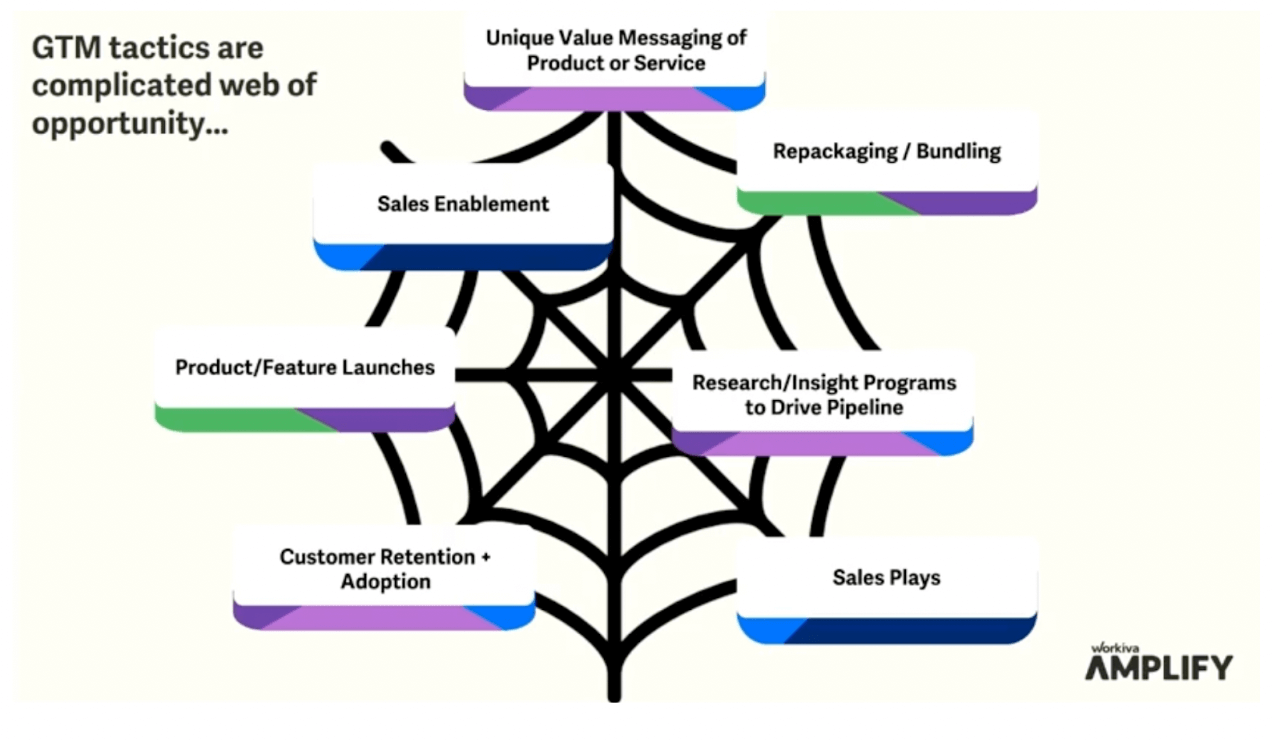
Now, you might be wondering about the web we mentioned in the title. Well, we’re not talking about the world wide web. When friends and family ask, “What do you do in product marketing?” our go-to analogy is that we are the spider in the middle of a complicated web. There's no part of the organization that we don't touch.
When it comes to GTM strategy, we're working with sales to improve sales enablement, messaging, and positioning.
We're working with marketing to drive demand generation in the campaigns they’re going to run.
We work with our pre-sales engineers; they’re responsible for our product demos, so we want to make sure the messages and frameworks we put together are woven into their talk track when they're showing our prospects and customers our awesome products.
Now, when you’re working with all these teams, it can feel like you’re being stretched in all directions.
If that sounds familiar to you, just know that you’re not alone. Navigating this web is one of the hardest parts of our job. This is where our best practices are really going to help you.
Go-to-Market launch best practices
Let's talk about launches, a key aspect of your Go-to-Market plan. Especially when you work for a tech company, it's really important to have a well-defined dev-to-launch process.
So, we work closely with our R&D team to define best practices for each phase of this process and look at how we can most effectively take our products and services to market. Now for a closer look at each of those phases.
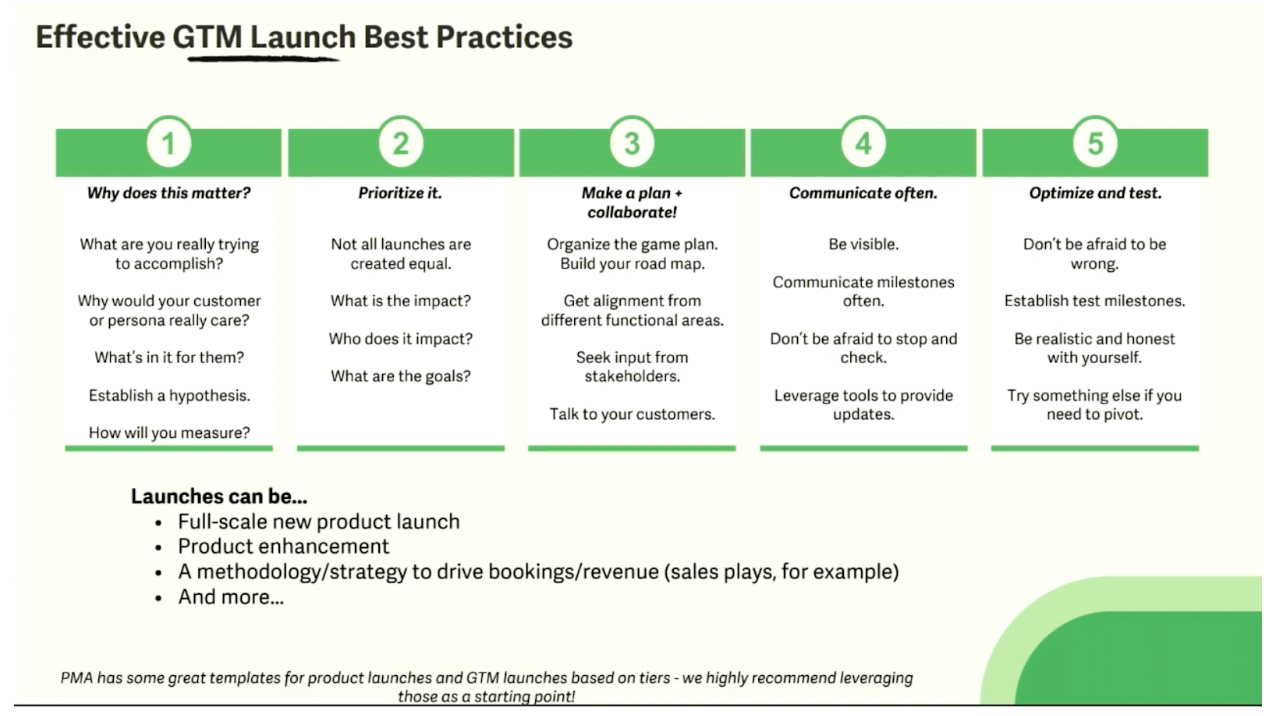
Phase one: Why does this matter?
First and foremost, it all comes back down to that why. Why should the customer care about this? What value are they going to gain from this? We’ve got to be able to monetize that. It's one thing to keep customers happy, but how are we making money off of it?
Phase two: Prioritize it
The next thing is prioritization. And it's not just prioritization in terms of the product roadmap but in terms of business priorities. Are we looking to elevate our win rate? Are we looking to increase the number of bookings? Is it about customer satisfaction? We work with so many different parts of the business with so many conflicting priorities, but we need to make sure that everybody's on the same page.
Phase three: Make a plan and collaborate
Once we've gotten through those first two steps, it's all about the planning. Maybe you’ve heard of the six Ps.
For PG purposes, we'll keep it to the five Ps: proper planning prevents poor performance. You’ve got to put your game plan together and make sure that everybody's clear on their roles and responsibilities.
Phase four: Communicate often
Once you have that plan in place, it's about communication. Think about all those stakeholders in the web and remind yourself that over-communication is never a bad thing. The last thing we want is for any stakeholder in our Go-to-Market process to get an unpleasant surprise, so we’re constantly giving them updates.
By the way, communication can take many different shapes and forms, so we always encourage our team to leverage all the channels they can. We’re doing meetings and Zoom calls, sending email follow-ups, and hitting people up on Slack channels.
The important thing is to share your message consistently and keep everyone up to date on the status of your plan.
Phase five: Optimize and test
Finally, it’s time to go to market and test our strategy. One of the beautiful things about being in software is that if we fail at something, we will fail fast and will hopefully fail forward. We take learnings from that, and we apply them to the next thing we do.
Often, companies get into the sunk cost fallacy. It's like, “Well, we invested so much time in this – we can't just get rid of it,” but that’s not always true. You’ve got to be able to test, move fast, and then move on.
The intricacies of Go-to-Market
Everything from revenue marketing to our product marketing, demand generation, campaign management, digital strategy, and content starts with our Go-to-Market plan. It’s a very complicated cycle, which you can see mapped out below.
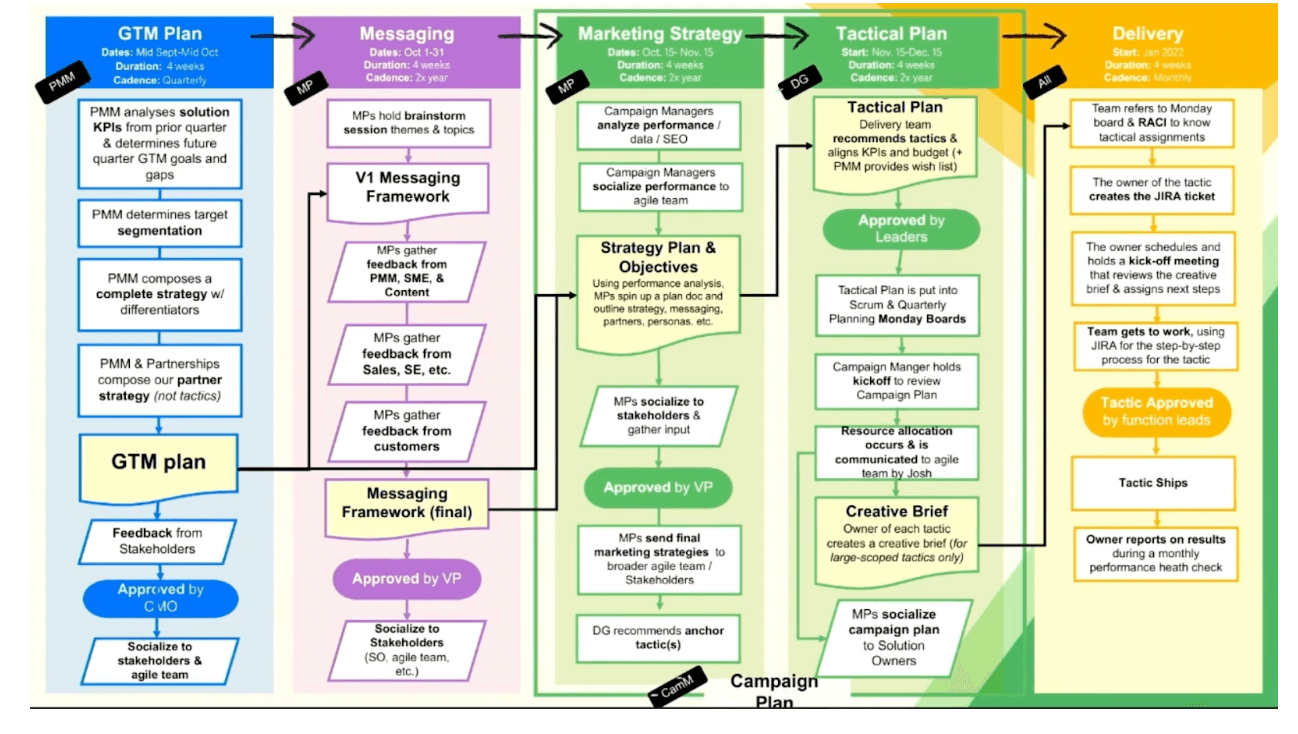
We're going through this cycle right now at Workiva, and it covers everything from what went well and what didn’t go so well in the last cycle to what our goals are for the upcoming cycle. That all then feeds into the messaging component.
That messaging goes into our marketing strategy, which is a lot more campaign-driven and tactical. We also look at where we’re going to invest our dollars in terms of sponsorships, webinars, and partnerships.
Next, we move on to the tactical plan, where everything from whitepapers to ebooks has to have a creative brief. And then finally, we deliver that launch.
Why the data doesn’t lie
An important part of what product marketing does is capturing and owning data. We need to use that data to understand the business. Where are we at in terms of bookings?
What does the pipeline multiplier look like today? What's the average deal size for our particular solution? We need to support all of that and help us plan for the next cycle.
During this phase, we want to highlight both quantitative and qualitative data. This is where gathering feedback comes in. One of the best things about being in product marketing is the interactions that we have with customers and with prospects.
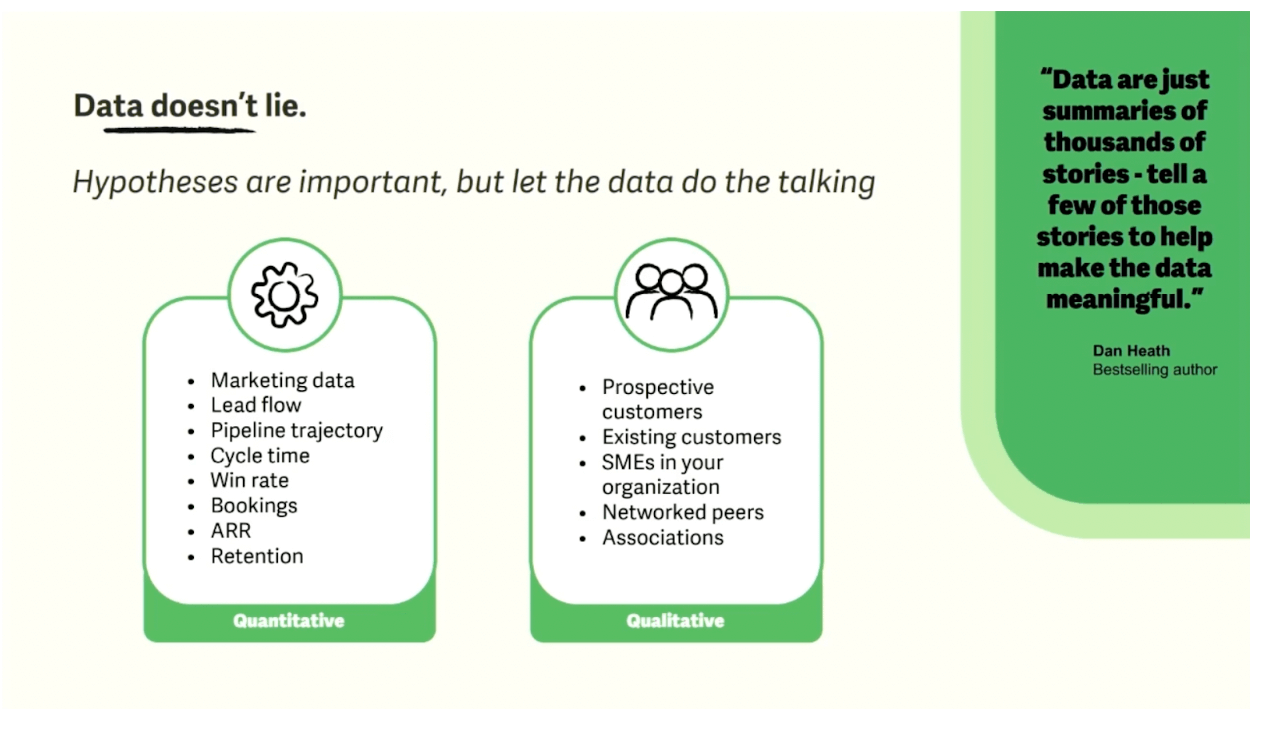
Now, if you’re in a super small startup, you might not have access to any data yet. That’s not a great position to be in – you feel like you’re going into all your strategies blind until you’ve got your data set up.
If that’s where you’re at, it is completely okay to use different kinds of data. Go back to basics and look at things like how many leads your website brings in. That will give you a starting point for a hypothesis. You can start building on that and then hopefully bring in someone with data expertise to build out a data system for you.
How to nail the persona-based approach
We all know that messaging is probably the most important and hardest part of our job. To help you navigate this challenge, we want to share how we’re approaching messaging at Workiva.
Not too long ago, we transitioned from a solution-based (i.e. one-product purchase) approach to a segment-based approach with our messaging. What we found is that while this was in some ways great, it wasn’t getting us in front of that sweet, sweet person who was going to, quite frankly, sign the check.
The segment-based approach wasn’t working for us, so we decided to switch to a more persona-based approach. This allows us to cast a wider net among the potential stakeholders within an organization and catch the ICPs we're looking for.
Now, we've all built personas – you have a little picture of a person, you give them a name, and you try to get your teams to connect with that emotionally.
We're shifting away from that type of persona because we want to decrease the bias it creates. We've all had our own unique personal experiences, and so has our customer. Traditional personas tend to ignore that.
Your personas don’t need names; they don’t need photos. Just get down to the brass tacks of the buyer’s psychology, what they care about, what's in it for them, and what their objectives and long-term goals are.
Another important thing to note is that personas are ever-changing. You need to regularly test your hypotheses and optimize your personas accordingly.
How to build a persona kit
Let’s take a quick look at the persona kit we’ve been developing, which is divided into three main sections:
Section one: The fundamentals of the anchor persona
- Persona heat map
- Demographics
- Emotive attributes
- Behavioral attributes
- Purchasing technology
We then use all of this data to build our messaging in the next section of the persona kit.
Section two: Messaging to the persona
- Core messaging theme
- Value framework
- Buyer journey messaging
We then bring those two parts together and, through the GTM plan, get into the tactical nuts and bolts:
Section three: Selling to the persona
- Sales enablement
- Prospecting kit
- Links to updated resources
This is where we build guides for sellers and campaign managers to leverage and help drive lead flow. We’ve found this kit to be invaluable in making our work and the way we navigate the GTM web more straightforward.
The soft skills that drive GTM strategy
There’re so many ways to describe product marketers. We’re the pitchers, quarterbacks, conductors, nuclei, coaches, the brains - we’re the spiders at the center of the web.
What all these analogies are getting at is that we straddle departments and we have to coordinate all their GTM efforts.
A great way to approach this is to treat each department like a different persona. If you’re talking to the VP of Sales, think about what their pain points are.
What's keeping them up at night? Are they getting pressure from the top because the numbers aren’t where they need to be? Do they have disgruntled employees who aren’t making their commission?
Whenever you go into GTM conversations, think about who you’re talking to.
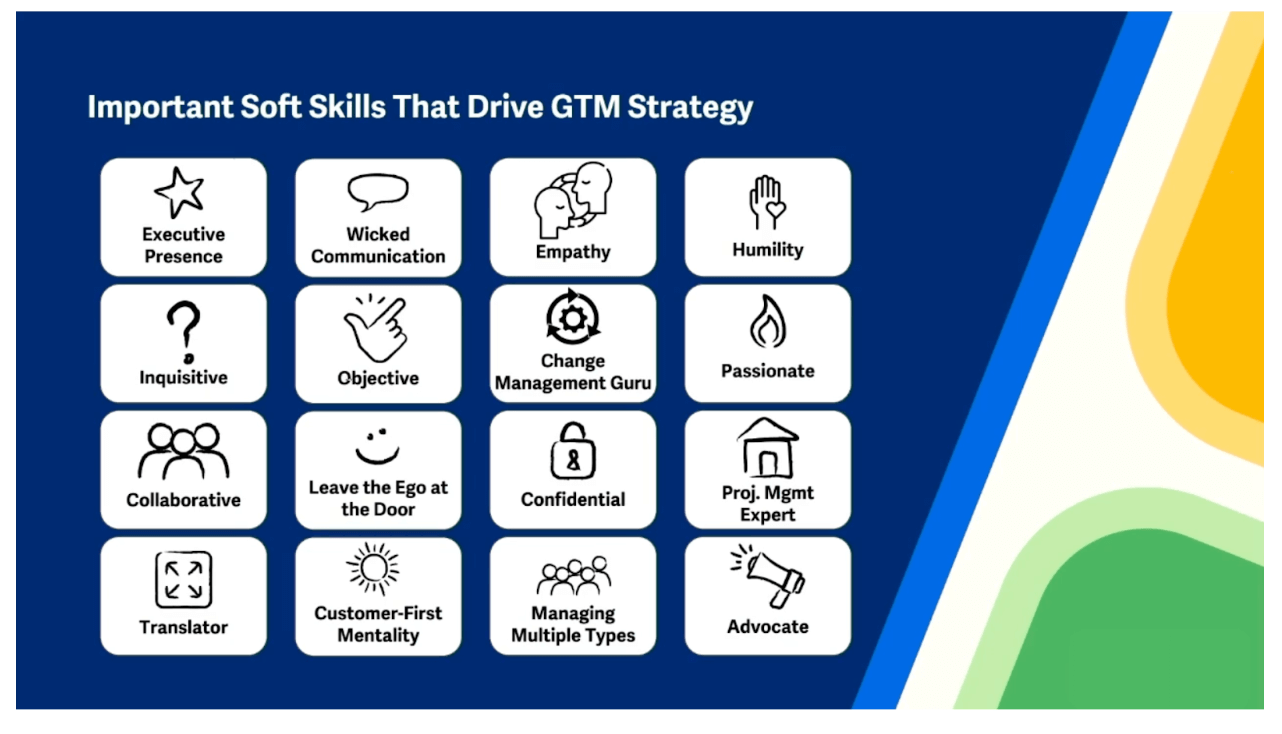
That’s just one example of a soft skill that’s going to help you drive your GTM strategy forwards. Let’s take a look at a few more.
- Humility: Launches won't always go the way you want them to. We've all been there. Maybe you expected your launch to produce certain results but it didn’t. Be humble and own that, but don't beat yourself up. It’s okay. You're going to learn from this.
- Executive presence: You will have to interact with your executives. At some point, they will see your work so it’s important to be able to articulate the data, understand the business objectives, and bring that story together.
- Inquisitiveness: We don't know everything, which is why it's important for us to be inquisitive, leave our egos at the door, and learn from other people. Once we bring everything we’ve learned together, we'll be able to tell the most complete and compelling stories.
Those are just some of the most important soft skills that we’ve identified over the course of our 20 years of product marketing.





